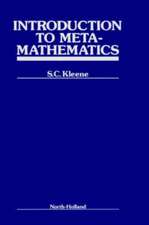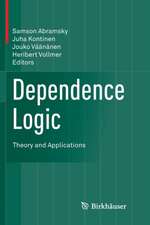Proofs and Fundamentals: A First Course in Abstract Mathematics: Undergraduate Texts in Mathematics
Autor Ethan D. Blochen Limba Engleză Hardback – 21 feb 2011
| Toate formatele și edițiile | Preț | Express |
|---|---|---|
| Paperback (1) | 466.92 lei 38-44 zile | |
| Springer – 19 apr 2013 | 466.92 lei 38-44 zile | |
| Hardback (1) | 449.60 lei 17-23 zile | +41.36 lei 5-11 zile |
| Springer – 21 feb 2011 | 449.60 lei 17-23 zile | +41.36 lei 5-11 zile |
Din seria Undergraduate Texts in Mathematics
- 17%
 Preț: 367.24 lei
Preț: 367.24 lei -
 Preț: 257.71 lei
Preț: 257.71 lei -
 Preț: 430.68 lei
Preț: 430.68 lei - 19%
 Preț: 400.52 lei
Preț: 400.52 lei -
 Preț: 400.42 lei
Preț: 400.42 lei -
 Preț: 367.40 lei
Preț: 367.40 lei - 19%
 Preț: 368.78 lei
Preț: 368.78 lei - 17%
 Preț: 395.93 lei
Preț: 395.93 lei -
 Preț: 304.91 lei
Preț: 304.91 lei -
 Preț: 372.26 lei
Preț: 372.26 lei - 17%
 Preț: 368.60 lei
Preț: 368.60 lei -
 Preț: 358.10 lei
Preț: 358.10 lei - 17%
 Preț: 373.59 lei
Preț: 373.59 lei -
 Preț: 392.20 lei
Preț: 392.20 lei -
 Preț: 424.14 lei
Preț: 424.14 lei - 17%
 Preț: 366.38 lei
Preț: 366.38 lei -
 Preț: 398.77 lei
Preț: 398.77 lei -
 Preț: 407.96 lei
Preț: 407.96 lei -
 Preț: 332.02 lei
Preț: 332.02 lei -
 Preț: 400.42 lei
Preț: 400.42 lei -
 Preț: 290.80 lei
Preț: 290.80 lei -
 Preț: 359.48 lei
Preț: 359.48 lei -
 Preț: 415.94 lei
Preț: 415.94 lei -
 Preț: 339.36 lei
Preț: 339.36 lei -
 Preț: 407.62 lei
Preț: 407.62 lei - 17%
 Preț: 362.67 lei
Preț: 362.67 lei -
 Preț: 404.13 lei
Preț: 404.13 lei -
 Preț: 436.78 lei
Preț: 436.78 lei -
 Preț: 370.77 lei
Preț: 370.77 lei -
 Preț: 402.33 lei
Preț: 402.33 lei - 13%
 Preț: 389.61 lei
Preț: 389.61 lei -
 Preț: 364.40 lei
Preț: 364.40 lei - 15%
 Preț: 417.73 lei
Preț: 417.73 lei -
 Preț: 298.00 lei
Preț: 298.00 lei -
 Preț: 329.94 lei
Preț: 329.94 lei - 19%
 Preț: 492.82 lei
Preț: 492.82 lei -
 Preț: 393.33 lei
Preț: 393.33 lei -
 Preț: 387.22 lei
Preț: 387.22 lei - 15%
 Preț: 517.21 lei
Preț: 517.21 lei -
 Preț: 399.05 lei
Preț: 399.05 lei - 15%
 Preț: 527.84 lei
Preț: 527.84 lei - 15%
 Preț: 444.52 lei
Preț: 444.52 lei - 15%
 Preț: 529.62 lei
Preț: 529.62 lei -
 Preț: 387.22 lei
Preț: 387.22 lei - 15%
 Preț: 571.19 lei
Preț: 571.19 lei - 15%
 Preț: 458.51 lei
Preț: 458.51 lei -
 Preț: 388.74 lei
Preț: 388.74 lei
Preț: 449.60 lei
Nou
Puncte Express: 674
Preț estimativ în valută:
86.11€ • 88.71$ • 72.13£
86.11€ • 88.71$ • 72.13£
Carte disponibilă
Livrare economică 29 ianuarie-04 februarie
Livrare express 17-23 ianuarie pentru 51.35 lei
Preluare comenzi: 021 569.72.76
Specificații
ISBN-13: 9781441971265
ISBN-10: 1441971262
Pagini: 386
Ilustrații: XXVI, 358 p.
Dimensiuni: 168 x 243 x 32 mm
Greutate: 0.74 kg
Ediția:2nd ed. 2011
Editura: Springer
Colecția Springer
Seria Undergraduate Texts in Mathematics
Locul publicării:New York, NY, United States
ISBN-10: 1441971262
Pagini: 386
Ilustrații: XXVI, 358 p.
Dimensiuni: 168 x 243 x 32 mm
Greutate: 0.74 kg
Ediția:2nd ed. 2011
Editura: Springer
Colecția Springer
Seria Undergraduate Texts in Mathematics
Locul publicării:New York, NY, United States
Public țintă
Lower undergraduateCuprins
Preface to the Second Edition.- Preface to the First Edition.- To the Student.- To the Instructor.- Part I. Proofs.- 1. Informal Logic.- 2. Strategies for Proofs.- Part II. Fundamentals.- 3. Sets.- 4. Functions.- 5. Relations.- 6. Finite and Infinite Sets.- Part III. Extras.- 7. Selected Topics.- 8. Explorations.- Appendix: Properties of Numbers.- Bibliography.- Index
Recenzii
“This is a well-written book, based on very sound pedagogical ideas. It would be an excellent choice as a textbook for a ‘transition’ course.” (Margret Höft, zbMATH 1012.00013, 2021)
“The contents of the book is organized in three parts … . this is a nice book, which also this reviewer has used with profit in his teaching of beginner students. It is written in a highly pedagogical style and based upon valuable didactical ideas.” (R. Steinbauer, Monatshefte für Mathematik, Vol. 174, 2014)
“Books in this category are meant to teach mathematical topics and techniques that will become valuable in more advanced courses. This book meets these criteria. … This book is well suited as a textbook for a transitional course between calculus and more theoretical courses. I also recommend it for academic libraries.” (Edgar R. Chavez, ACM Computing Reviews, February, 2012)
“This is an improved edition of a good book that can serve in the undergraduate curriculum as a bridge between computationally oriented courses like calculus and more abstract courses like algebra.” (Teun Koetsier, Zentralblatt MATH, Vol. 1230, 2012)
“The contents of the book is organized in three parts … . this is a nice book, which also this reviewer has used with profit in his teaching of beginner students. It is written in a highly pedagogical style and based upon valuable didactical ideas.” (R. Steinbauer, Monatshefte für Mathematik, Vol. 174, 2014)
“Books in this category are meant to teach mathematical topics and techniques that will become valuable in more advanced courses. This book meets these criteria. … This book is well suited as a textbook for a transitional course between calculus and more theoretical courses. I also recommend it for academic libraries.” (Edgar R. Chavez, ACM Computing Reviews, February, 2012)
“This is an improved edition of a good book that can serve in the undergraduate curriculum as a bridge between computationally oriented courses like calculus and more abstract courses like algebra.” (Teun Koetsier, Zentralblatt MATH, Vol. 1230, 2012)
Notă biografică
Dr. Ethan D. Bloch of Bard College is the author of two Springer publications "A First Course in Geometric Topology and Differential Geometry," and the first and second editions of, "Proofs and Fundamentals: A First Course in Abstract Mathematics." More information about Dr. Ethan D. Bloch can be found on his person web page: http://math.bard.edu/bloch
Textul de pe ultima copertă
This textbook is designed to introduce undergraduates to the writing of rigorous mathematical proofs, and to fundamental mathematical ideas such as sets, functions, relations, and cardinality. The book serves as a bridge between computational courses such as calculus and more theoretical courses such as linear algebra, abstract algebra, and real analysis.
This second edition has been significantly enhanced, while maintaining the balance of topics and careful writing of the previous edition. Part 1 presents logic and basic proof techniques; Part 2 thoroughly covers fundamental material such as sets, functions and relations; and Part 3 introduces a variety of extra topics such as groups, combinatorics and sequences, and suggests avenues for independent student explorations.
A gentle, friendly style is used, in which motivation and informal discussion play a key role, and yet high standards in rigor and in writing are never compromised.
Reviews of the first edition:
This is a well-written book, based on very sound pedagogical ideas. It would be an excellent choice as a textbook for a 'transition' course.
—Zentralblatt Math
'Proofs and Fundamentals' has many strengths. One notable strength is its excellent organization... There are large exercise sets throughout the book... the exercises are well integrated with the text and vary appropriately from easy to hard... Perhaps the book’s greatest strength is the author’s zeal and skill for helping students write mathematics better.
—MAA Online
This second edition has been significantly enhanced, while maintaining the balance of topics and careful writing of the previous edition. Part 1 presents logic and basic proof techniques; Part 2 thoroughly covers fundamental material such as sets, functions and relations; and Part 3 introduces a variety of extra topics such as groups, combinatorics and sequences, and suggests avenues for independent student explorations.
A gentle, friendly style is used, in which motivation and informal discussion play a key role, and yet high standards in rigor and in writing are never compromised.
Reviews of the first edition:
This is a well-written book, based on very sound pedagogical ideas. It would be an excellent choice as a textbook for a 'transition' course.
—Zentralblatt Math
'Proofs and Fundamentals' has many strengths. One notable strength is its excellent organization... There are large exercise sets throughout the book... the exercises are well integrated with the text and vary appropriately from easy to hard... Perhaps the book’s greatest strength is the author’s zeal and skill for helping students write mathematics better.
—MAA Online
Caracteristici
A gentle, friendly style is used, in which motivation and informal discussion play a key role The material is presented in the way that mathematicians actually use it; good mathematical tast is preferred to overly clever pedagogy There is an important section devoted to the proper writing of proofs Includes supplementary material: sn.pub/extras



























